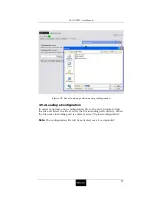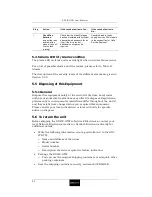
SDI-IP-GTW User Manual
69
QoS:
Quality of Service. A common term for a set of parameters
describing the quality you get from an IP network: Throughput,
availability, delay, jitter and packet loss.
QPSK:
Quadrature Phase-Shift Keying. The digital modulation type
typically used for transmission of digital TV signals over satellite. Often
referred to as DVB-S.
RIP2:
Routing Information Protocol v2. A protocol used between
network routers to exchange routing tables and information.
RSVP:
ReSerVation Protocol. A Quality-of-service oriented protocol used
by network elements to reserve capacity in an IP network before a
transmission takes place.
RTP:
Real-time Transfer Protocol. A protocol designed for transmission
of real-time data like video and audio over IP networks. RTP is used for
most video over IP transmissions.
SDI:
Serial Digital Interface. Also known as ANSI/SMPTE 259M-1997
or ITU-R BT.656. A specification describing how to digitize and transmit
uncompressed video signals. The typical bit rate of an SDI signal is
270Mbit/s.
SDP:
Session Description Protocol. A protocol to signal multicasts in a
network. SDP is used as a mechanism to describe an ongoing
multicast; for example the type of compression used, IP addresses etc.
SDTI:
Serial Data Transport Interface. A mechanism that allows
transmission of various types of data over an SDI signal. This may be
one or more compressed video signals or other proprietary data types.
The advantage of SDTI is that existing SDI transmission infrastructure
can be used to transport other types of data.
SDTV:
Standard Definition Television. The normal television
standard/resolution in use today.
SFP:
Small Form-factor Pluggable module. A standardized mechanism
to allow usages of various optical interfaces for Gigabit Ethernet.
Several types of SFP modules exist: Single mode fiber modules for long-
distance transmission and multi mode fiber modules for shorter
distances. SFP is also known as "mini-GBIC".
SIP:
Session Initiation Protocol. A common acronym for the ongoing
effort to standardize
signaling
over IP networks, i.e. connection setup
and tear-down. SIP makes it possible to "dial" a remote receiver of data
and set up the connection in this way.
SNMP:
Simple Network Management Protocol. A fundamental, simple
protocol for management of network elements. Very common in use
today by most Network Management Systems and other applications.
Summary of Contents for SDI-IP-GTW
Page 1: ...network electronics com SDI to IP Gateway Rev 1 3 0 Flashlink User Manual SDI IP GTW...
Page 2: ...This page is intentionally left blank...
Page 4: ...SDI IP GTW User Manual 4 This page is intentionally left blank...
Page 8: ...SDI IP GTW User Manual 8 This page is intentionally left blank...
Page 56: ...SDI IP GTW User Manual 56 This page is intentionally left blank...
Page 61: ...SDI IP GTW User Manual 61 Figure 31 Data flow between two units...
Page 62: ...SDI IP GTW User Manual 62 This page is intentionally left blank...














































